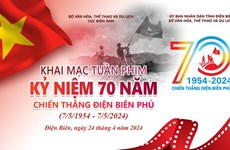Hue festival showcases unique traditional crafts and skills
The Hue Craft Village Festival, which artisans from localities across
the country attend to display their handicraft skills, opened on April
28 evening in Hue ancient imperial city in the central province of Thua
Thien-Hue.
The Hue Craft Village Festival, which artisans from localities across
the country attend to display their handicraft skills, opened on April
28 evening in Hue ancient imperial city in the central province of Thua
Thien-Hue.
The opening ceremony began with lights, colours and music that gave a glimpse of the uniqueness of the craft villages participating in the festival. "The festival is to honour the quintessence of craftsmanship in the villages," Nguyen Van Thanh, head of the festival's organisers, said at the ceremony.
About 150 artisans from 34 craft villages in the country, including those involved with wood and bronze casting, conical-hat making, traditional embroidery and manual textile production, are participating in the festival.
The biennial event will run till May 3, with artisans from Saijo in Japan and Gyeongju in the Republic of Korea also participating in it.
Earlier in the day, the space dedicated to performances by artisans and exhibitions of craft products was opened at Nguyen Dinh Chieu Street, adjacent to Tu Tuong Park and the Culture Museum.
More than 10 nha ruong (Hue-style houses with wooden beams and pillars) have been erected as exhibition rooms, where visitors will get a chance to shop for products and see artisans make the local Thanh Tien paper flowers, Sinh paper paintings, Bat Trang pottery from Hanoi and Bau Truc terracotta from Ninh Thuan central province.
The house exhibiting Thanh Tien paper flowers attracted large crowds, as people watched in amazement the transformation of paper into art.
The Tu Tuong Park will display woven products, including the ethnic Zeng textiles from local mountainous A Luoi District, the ethnic Tho Cam textiles from the northern mountainous Ha Giang Province, the local Thuy Thanh conical hats and Thuan Loc hand embroidery.
The house of Hoi An silk, where the complete production circle of silk was on display, attracted many foreigners. Visitors can see the silkworm, the cocoon, the boiling and the weaving processes and the final product.
In recent years, Truc Chi, which is a kind of artistic paper, has emerged as the best representative of the combination of traditional craft techniques and contemporary art. In the final process of making each paper sheet, the artisans add graphic designs to make the sheet itself an individual art item.
Understandably, the Truc Chi exhibition at the Hue Culture Museum was crowded, with the visitors appreciating the use of the paper to make clothes, wallets, lanterns and umbrellas, besides boxes, candle holders and paintings.
At the museum, visitors can see the kimono, the Japanese national costume, alongside a collection of royal and mandarin costumes from the Nguyen Dynasty (1802-1945), and embroidery paintings of poems by local veteran artisan Le Van Kinh.
The festival offers visitors a wide choice of Vietnamese craftsmanship. However, the ambience might be boring to the local people, as the fourth event uses the same motif as of the previous biennial festivals, the first one being held in 1999.
Some visitors said they expected the preservation of traditional crafts, but wanted creativity in the organisation of the festival also.-VNA
The opening ceremony began with lights, colours and music that gave a glimpse of the uniqueness of the craft villages participating in the festival. "The festival is to honour the quintessence of craftsmanship in the villages," Nguyen Van Thanh, head of the festival's organisers, said at the ceremony.
About 150 artisans from 34 craft villages in the country, including those involved with wood and bronze casting, conical-hat making, traditional embroidery and manual textile production, are participating in the festival.
The biennial event will run till May 3, with artisans from Saijo in Japan and Gyeongju in the Republic of Korea also participating in it.
Earlier in the day, the space dedicated to performances by artisans and exhibitions of craft products was opened at Nguyen Dinh Chieu Street, adjacent to Tu Tuong Park and the Culture Museum.
More than 10 nha ruong (Hue-style houses with wooden beams and pillars) have been erected as exhibition rooms, where visitors will get a chance to shop for products and see artisans make the local Thanh Tien paper flowers, Sinh paper paintings, Bat Trang pottery from Hanoi and Bau Truc terracotta from Ninh Thuan central province.
The house exhibiting Thanh Tien paper flowers attracted large crowds, as people watched in amazement the transformation of paper into art.
The Tu Tuong Park will display woven products, including the ethnic Zeng textiles from local mountainous A Luoi District, the ethnic Tho Cam textiles from the northern mountainous Ha Giang Province, the local Thuy Thanh conical hats and Thuan Loc hand embroidery.
The house of Hoi An silk, where the complete production circle of silk was on display, attracted many foreigners. Visitors can see the silkworm, the cocoon, the boiling and the weaving processes and the final product.
In recent years, Truc Chi, which is a kind of artistic paper, has emerged as the best representative of the combination of traditional craft techniques and contemporary art. In the final process of making each paper sheet, the artisans add graphic designs to make the sheet itself an individual art item.
Understandably, the Truc Chi exhibition at the Hue Culture Museum was crowded, with the visitors appreciating the use of the paper to make clothes, wallets, lanterns and umbrellas, besides boxes, candle holders and paintings.
At the museum, visitors can see the kimono, the Japanese national costume, alongside a collection of royal and mandarin costumes from the Nguyen Dynasty (1802-1945), and embroidery paintings of poems by local veteran artisan Le Van Kinh.
The festival offers visitors a wide choice of Vietnamese craftsmanship. However, the ambience might be boring to the local people, as the fourth event uses the same motif as of the previous biennial festivals, the first one being held in 1999.
Some visitors said they expected the preservation of traditional crafts, but wanted creativity in the organisation of the festival also.-VNA












